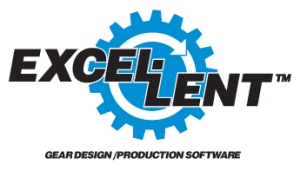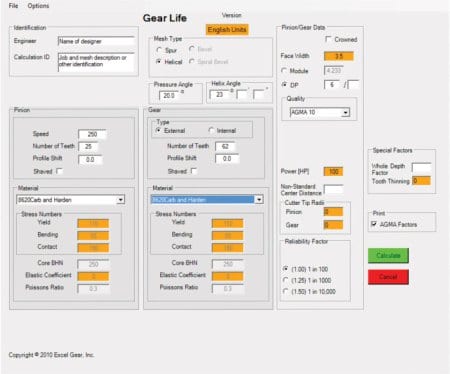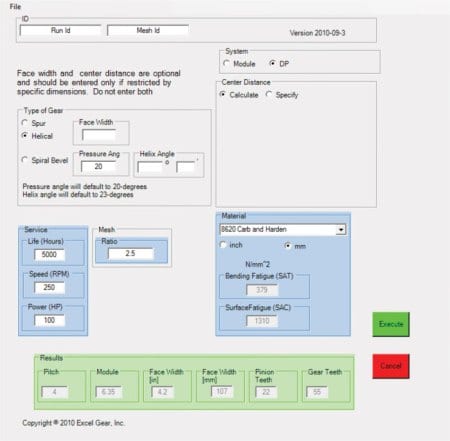Contact us today:

(847) 934-4500
tdaro@bernardandcompany.com

Contact us today:
(847) 934-4500
tdaro@bernardandcompany.com

 Excel-lentTM software from longtime builder of gears and gearboxes quickly determines optimum product parameters for various industries; time savings in hundreds of engineering hours being realized
Excel-lentTM software from longtime builder of gears and gearboxes quickly determines optimum product parameters for various industries; time savings in hundreds of engineering hours being realized
In response to the gear market’s need for optimization software, which has been lacking for many years, Excel-LentTM gear/gearbox design and analysis software has been developed by Excel Gear, Inc. (Roscoe, IL) and written in Visual Basics.Net. This software has been written by engineers who also design and manufacture gears for their own use, according to company president N.K. “Chinn” Chinnusamy.
Mr. Chinnusamy further comments, “Although commercial software has long been available in the gear industry, it has been too expensive or too complicated to be used by engineers without specialized gear design knowledge. Our software is specifically designed with a user-friendly interactive input screen providing defaults and options in accordance with the AGMA 2001 standard (American Gear Manufacturers Association).” The users of Excel-Lent software can easily navigate through the input screens to edit, analyze and produce reports on the optimum gear and gearbox design for various industrial and other applications.
“This software is not designed for any specific industry,” continues Chinnusamy. It can be used for machine tools, heavy materials handling equipment or even the wind turbine industry. For the wind turbine industry, for example, the designer needs a full understanding of all the operating loads on the gear members to arrive at the required power rating.
The key calculations performed are the AGMA power rating and load calculations, including bending strength geometry factor (J) and pitting resistance geometry factors (I). Output from the software is a single page of data printed in a format that is easy to read and interpret. Other commercial software typically prints five or six pages of information, which may be confusing to most design engineers unless they are gear experts, Chinnusamy further observed.
The users of Excel-Lent need not be familiar with AGMA standards to use this software. Those who are not gear engineers can also benefit from the gear engineering knowledge embedded in the software package.
Excel-Lent contains three sections – design, analysis and gear dimensions. Any of the sections can be used individually to run calculations. On a typical job, according to Excel Gear, hundreds of hours typically spent doing the calculations can be saved.
The three sections are detailed below:
 DESIGN: This section calculates the size of gears, based on minimal input by the user. The user needs to specify only the input rotational speed, gear ratio, power to be transmitted and the material and heat treatments selected from the material tables of all commonly used materials in the industry.
DESIGN: This section calculates the size of gears, based on minimal input by the user. The user needs to specify only the input rotational speed, gear ratio, power to be transmitted and the material and heat treatments selected from the material tables of all commonly used materials in the industry.
Key values calculated are the diameter and face width of the pinion required to achieve the surface fatigue power rating and optimized DP or module (based on the calculated diameter) required for the bending fatigue power rating. The data are automatically exported to the analysis program for detailed analysis. The results are the power ratings for 5,000 -100,000 hours of B1 life (reliability factor of 1).
If required, other values such as face width or center distance may be entered but Excel Gear recommends leaving the face width and center distance values blank for optimized gear design. Design and analysis programs are used to design one gear stage in sequence on an external or internal spur and helical gear mesh.
ANALYSIS: This program calculates the power rating of a gear set for 5,000, 10,000, 25,000, 50,000 and 100,000 hours of B1 life (reliability factor of 1). Reliability factor of 1, 1.25, or 1.5 can be selected, as required. The user needs to input mesh type (spur, helical, internal and external), pressure angle, helix angle (if applicable), pinion speed, number of teeth in pinion and gear, material (from the list provided in the software), face width, DP or module and quality required. Crown and/or profile shift, if used, can also be entered. The program will calculate the power rating of the gear set and show HP or KW capability along with torque, tangential force and static capacity. Static capacity is based on yield strength and, if bending stress exceeds yield strength at any time, permanent deformation or even tooth breakage may occur. If the results are satisfactory, the user can print the single page results only or, optionally, also print all the AGMA factors used in making the calculations.
Most commercially available gear software will generate five or six pages of output along with required bending and surface fatigue strength of the gear set. The user therefore needs knowledge of metallurgy to select proper material and heat treatment or must consult a metallurgist. By contrast, the Excel-Lent software program lists commonly used gear material for the user to select. If the results are not as required, the user can select another material or change other design criteri a as required to achieve the desired results. If a special material is desired, its yield, bending and contact stress numbers can be easily entered. If any of the required input data are missing, the program will prompt the user to supply what is missing. Metric or inch units can also be selected with just one click.
a as required to achieve the desired results. If a special material is desired, its yield, bending and contact stress numbers can be easily entered. If any of the required input data are missing, the program will prompt the user to supply what is missing. Metric or inch units can also be selected with just one click.
DIMENSIONS: In the opinion of the manufacturer, this Excel-Lent gear dimension software is the most versatile program available in the market. The program will calculate the manufacturing dimensions for a new pinion and gear or calculate the dimension of a pinion or gear to mate an existing pinion or gear. This can be done for external gears, internal gears or a gear rack. Users need only to enter the type of mesh (spur or helical, internal of external), pressure angle, helix angle(if helical gears), number of teeth in pinion and mating gear, DP or module and the quality of the gears.
The program will then calculate the center distance, dimension over pins, span measurement, form diameter, roll angles and all gear tolerances to match the quality required (AGMA, DIN, or ISO). The program will calculate the helix angle required to match a specified center distance if the user chooses that option.
The program displays plain English error messages when input is questionable or in error. For example, if the center distance is incorrect, the program will flash error messages such as, “Center distance specified is too large/small.”
The program calculates optimized profile shifts for pinion and gear operating at a non-standard center distance, if the operating center distance is specified. If the profile shift required to operate is large and makes the top land narrow, the program will flash warning messages and display the proper profile shift amount to avoid narrow top land.
Excel-Lent software further provides users the option to balance beam strength or specific sliding of gear and pinion, if desired. This is a key requirement for wind turbine gears. The program will also calculate gear blank tolerances to achieve the desired quality level, if shaft and bore diameters are entered. Users can switch between inch and metric dimensions with one click.
For further information or a test demo, available on CD or onsite, please contact:
EXCEL GEAR, INC.
11865 Main Street
Roscoe, IL 61073
Phone: 815-623-3414
Fax: 815-623-3314
Web: www.excelgear.com
Email: sales@excelgear.com
Attention: N.K. Chinnusamy or Bill Powers
ABOUT EXCEL GEAR
Excel Gear brings over 50 years of machine tool experience to the design, manufacturing and quality analysis of its various gear, gearbox, fluid bearing, spindle, CNC gimbal head, nutator and special equipment production. ANSYS software for FEA on stress, strain, deflection, as well as modal analysis, time and frequency domain, our Spindle Analysis Program, MATLAB/Simulink, AutoCAD/SolidWorks/CADAM and other programs are all utilized to affect the best solutions to customer requirements. Excel also builds two-axis CNC gimbal heads with 20,000 RPM motorized spindle, 15,000 RPM cartridge type spindle assemblies and CNC rotary tables for major machine tool companies. Our high-accuracy gear grinding equipment produces to AGMA 15 (DIN 2) tolerances for quality that meets or exceeds the increasing customer demands for high-speed and high power transmission with smooth, quiet operation. Recently, the company has entered the emerging wind turbine market to provide various gears and gearbox components, as well as extensive maintenance and system performance engineering assistance.
PR agency:
Tim Daro
Bernard & Company
tdaro@bernardandcompany.com